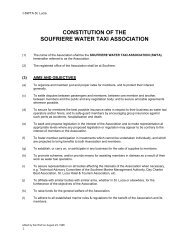WWF Cover photo - Soufriere Marine Management Association ...
WWF Cover photo - Soufriere Marine Management Association ...
WWF Cover photo - Soufriere Marine Management Association ...
You also want an ePaper? Increase the reach of your titles
YUMPU automatically turns print PDFs into web optimized ePapers that Google loves.
Inside the reserve CPUE (blue cod per minute per rod) increased by 100% after just 11 months of protection, andcontinued to increase for four years after the reserve was established from approximately 0.28 blue cod perminute per rod to 1.2 blue cod per minute per rod, a four-fold increase. By contrast, CPUE outside the reserveremained approximately constant throughout the study (around 0.2 blue cod per minute per rod) (Figure 2).Control sites ranged from 1.3 to 5.6km from the reserve boundary, suggesting there was no enhancement ofCPUE by spillover at these distances for this species.Mean CPUE (cod caught per minute)1.81.61.41.21.00.80.60.40.20.0-0.2-0.4ControlsReserves0 5 10 15 20 25 30 35 40 45 50 55 60 65 70 75 80 85 90Months since reserve establishmentFigure 2: Mean catch per unit effort in blue cod per minute fished per rod forreserves and control sites from September 1993 to April 2000. Error barsshow +/- 1 S.E. Redrawn with permission from Davidson 2001.Davidson’s (2001) study provides the longest time series of data available for any New Zealand <strong>Marine</strong> Reserve(9 years for densities and 6.5 years for fish lengths and catch rates). It demonstrates dramatic changes in the size,population structure, abundance and behaviour of the dominant reef species, blue cod. In April 2000 (after 84months of protection) blue cod were over 125% more abundant within the reserve and on average 8cm longerthan in exploited sites. (The fish were bigger in the marine reserves than in the control sites at the outset offormal reserve management. Davidson attributes this to the previously voluntary closure of the area for 4 yearsby local dive clubs). A key finding from Davidson’s (2001) research was that by the end of the study large fishwere much more common in the reserve. Thirty five percent of cod in reserves were larger than 33cm comparedto



